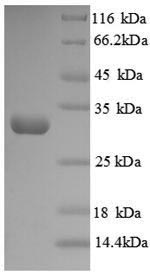Recombinant Human Protein-lysine 6-oxidase (LOX) is produced in E.coli and covers a partial protein region spanning amino acids 174 to 417. The protein features an N-terminal 6xHis-tag, which streamlines purification and detection processes. The product achieves a purity level that exceeds 90% when verified by SDS-PAGE, suggesting reliable performance across various research applications.
Protein-lysine 6-oxidase (LOX) appears to be a crucial enzyme within the human body. It plays what seems to be a critical role in crosslinking collagen and elastin fibers—components that are essential for maintaining structural integrity in connective tissues. Research focusing on tissue remodeling, fibrosis, and related cellular processes often considers LOX an important component.
Potential Applications
Note: The applications listed below are based on what we know about this protein's biological functions, published research, and experience from experts in the field. However, we haven't fully tested all of these applications ourselves yet. We'd recommend running some preliminary tests first to make sure they work for your specific research goals.
1. Protein-Protein Interaction Studies Using His-Tag Pull-Down Assays
The N-terminal 6xHis-tag on this recombinant LOX protein allows for nickel-affinity based pull-down experiments that can identify potential binding partners or cofactors. This partial protein sequence (174-417aa) represents a substantial portion of the LOX protein and may retain important binding domains for interactions with other proteins or substrates. Pull-down assays can be performed using cell lysates or purified protein libraries to map what might be the LOX interactome. The >90% purity level appears sufficient for these interaction studies, since minor contaminants are unlikely to interfere with specific binding events.
2. Antibody Development and Validation
This recombinant LOX protein could serve as an immunogen for generating polyclonal or monoclonal antibodies specific to human LOX. The partial sequence (174-417aa) likely provides sufficient antigenic epitopes for antibody production while potentially avoiding issues with the N-terminal signal peptide region. With >90% purity, antibodies should be primarily directed against LOX rather than contaminants. Generated antibodies can be validated using this same recombinant protein in Western blot, ELISA, or immunoprecipitation assays.
3. His-Tag Based ELISA Development
The N-terminal 6xHis-tag opens possibilities for developing sandwich ELISA assays where this recombinant LOX can be captured using anti-His antibodies or immobilized on nickel-coated plates. This setup may enable quantitative detection studies or screening assays for LOX-binding compounds. The >90% purity level appears adequate for ELISA applications where the His-tag provides specificity for protein capture. Such assays could potentially be used to study LOX expression levels in biological samples or screen for possible inhibitors.
4. Biochemical Characterization and Stability Studies
This recombinant LOX protein might be useful for basic biochemical characterization, including thermal stability analysis, pH sensitivity studies, and buffer optimization experiments. The partial sequence (174-417aa) appears to cover key structural domains that could provide insights into protein folding and stability properties. Size exclusion chromatography and dynamic light scattering experiments may help determine the oligomerization state and aggregation behavior of this LOX construct. These studies could provide fundamental biochemical data necessary for understanding LOX protein properties in vitro.




